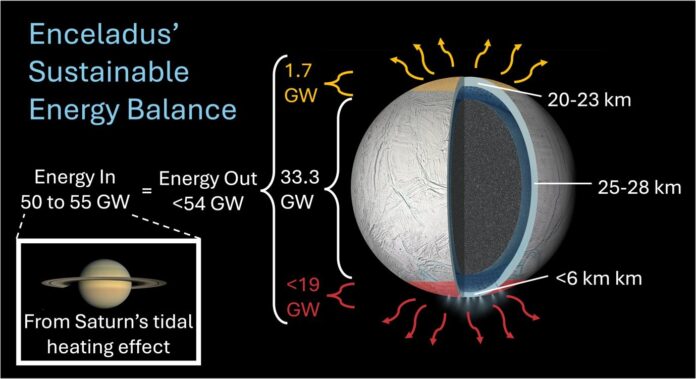Enceladus, one of Saturn’s many moons, is considered a prime candidate in the search for extraterrestrial life. New research suggests this icy world could host a surprisingly stable ocean capable of supporting life – even further boosting its potential as an alien oasis.
Scientists long believed Enceladus was geologically active primarily at its south pole, where massive plumes of water vapor and ice erupt from fissures in the surface, hinting at a vast saltwater ocean beneath its icy shell. This ocean is thought to be warmed by tidal forces generated by Saturn’s gravity as Enceladus orbits, offering an intriguing mix of liquid water, heat, and organic molecules – key ingredients for life as we know it.
However, the existence of this potential life haven relies on a delicate balance: enough heat from tidal forces to keep the ocean liquid, but not so much that it boils away or destabilizes its environment. Previously, heat loss measurements were confined to the south pole. Now, scientists have found evidence of significant heat emanating from Enceladus’s north pole – overturning previous assumptions about this region being geologically inactive.
Using data from NASA’s Cassini spacecraft, researchers compared infrared observations of Enceladus’s north pole during winter and summer. These measurements revealed surface temperatures unexpectedly warmer than expected based on the moon’s frigid environment. This anomaly points to heat radiating outwards from a warm subsurface ocean.
The team estimated the north polar heat flow at around 46 milliwatts per square meter – though seemingly small, this is comparable to Earth’s continental crust heat loss. Across the entire moon, this conductive heat loss totals approximately 35 gigawatts, adding to the previously estimated heat escaping from the south pole.
The total figure for Enceladus’s global heat loss now sits at around 54 gigawatts – strikingly close to the predicted amount generated by tidal forces. This tight match suggests that Enceladus’s subsurface ocean is indeed in a long-term thermal equilibrium, capable of remaining liquid over vast periods and providing a potentially habitable environment for life.
“Understanding how much heat Enceladus loses globally is crucial to knowing whether it can support life,” explains Dr. Carly Howett from the University of Oxford and the Planetary Science Institute, lead author on the study. “This new result strongly supports the long-term sustainability of Enceladus’s ocean – a key ingredient for life to emerge and potentially thrive.”
While this discovery is immensely encouraging, there are still mysteries to unravel. Researchers are eager to determine the age of Enceladus’s ocean, as its longevity directly impacts the possibility of life arising within it.
Furthermore, Cassini’s thermal data has allowed scientists to refine estimates of the moon’s icy shell thickness, a vital factor for future missions planning to explore Enceladus’s ocean directly – perhaps with robotic landers or submersibles. This study suggests the ice shell is about 20-28 km deep, slightly thicker than earlier estimations.
This research highlights the power of long-term planetary exploration missions like Cassini in revealing hidden details about celestial bodies. Data collected over decades can unlock secrets that might not have been evident initially, pushing the boundaries of our understanding of habitable environments beyond Earth.





























